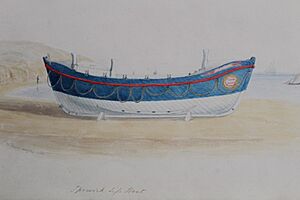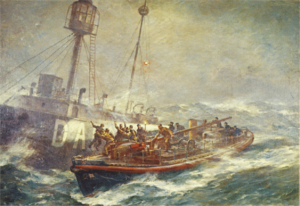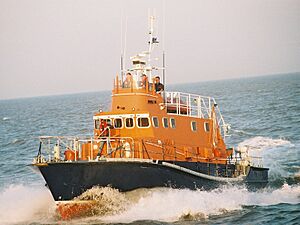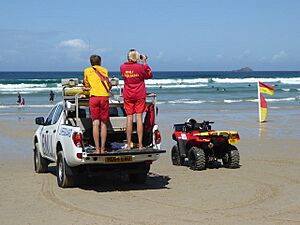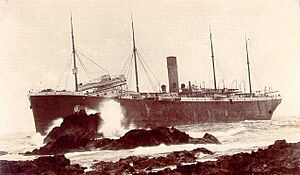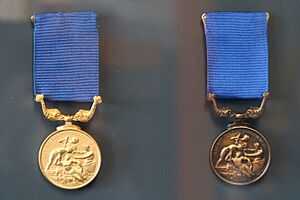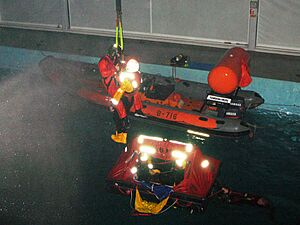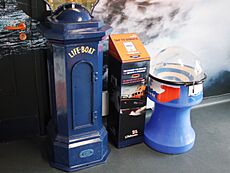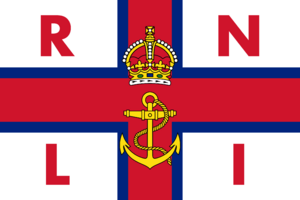Royal National Lifeboat Institution facts for kids
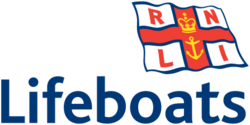 |
|
| Abbreviation | RNLI |
|---|---|
| Formation | 4 March 1824 |
| Type | Life savers |
| Legal status | Registered charity |
| Purpose | To save lives at sea. |
| Headquarters | Poole, Dorset, England |
|
Region served
|
|
|
Patron
|
King Charles III |
|
President
|
Prince Edward, Duke of Kent |
|
Chief executive
|
Peter Sparkes |
|
Main organ
|
The Lifeboat |
|
Budget (2022)
|
£221.6 million |
|
Staff (2022)
|
2,501 |
|
Volunteers (2022)
|
9,800 crew |
The Royal National Lifeboat Institution (RNLI) is a special charity that saves lives at sea. It is the biggest lifeboat service around the coasts of the United Kingdom, Ireland, the Channel Islands, and the Isle of Man. They also help on some rivers and lakes.
The RNLI started in 1824. It was first called the National Institution for the Preservation of Life from Shipwreck. Soon after, King George IV supported them, and they added "Royal" to their name. Today, King Charles III is still their patron. The charity changed its name to the Royal National Lifeboat Institution in 1854.
The RNLI is based in Poole, Dorset, England. Most of their money comes from gifts left in wills and from donations. Most of the people who work on their lifeboats are volunteers. They have over 400 lifeboats at 238 stations. The RNLI also has paid lifeguards who work on nearly 250 beaches. They give free safety advice and have worked with other countries since 1924.
Contents
History of Saving Lives
How the RNLI Started
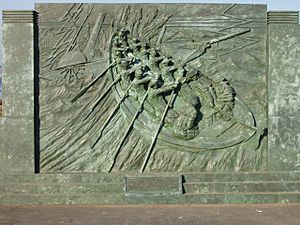
In 1822, many ships crashed near the Isle of Man. This made a kind man named William Hillary want to create a national group to save people from shipwrecks. At first, the government didn't help much. But with support from important people like King George IV, a public meeting was held in London in 1824.
At this meeting, they decided to form the National Institution for the Preservation of Life from Shipwreck. King George IV quickly allowed them to add "Royal" to the name. The first president was the Prime Minister, Robert Jenkinson, 2nd Earl of Liverpool.
The new group had three main goals:
- To give awards (medals or money) to people who rescued others from shipwrecks.
- To provide special equipment, like line-throwing mortars, to coastguard and lifeboat stations.
- To put lifeboats in as many places as possible along the coast.
They looked at different lifeboat designs. Early boats were heavy and costly. A lighter design by George Palmer became the standard until the 1850s.
Growing Stronger
In its early years, the RNLI didn't have much money. By 1850, they had very little. But a new leader, Richard Lewis, became Secretary. For the next 33 years, he worked hard to raise money. By 1882, their income had grown a lot.
Other changes helped too. Experienced naval officers joined the committee. Captain John Ross Ward helped design and introduce cork lifejackets for volunteers.
The Duke of Northumberland started a competition for a new lifeboat design. This boat could use both oars and sails. A design by James Peake became the main choice for many years.
In 1854, the RNLI focused only on saving lives. Another group, the Shipwrecked Fishermen and Mariners' Benevolent Society, took care of people after they were rescued. This is when the RNLI dropped "shipwreck" from its name. The RNLI also got a small amount of money from the government for a while, but they stopped taking it by 1869.
In 1886, 27 lifeboat crew members from Southport and St Annes died during a rescue. This sad event led Charles Macara to start raising more money for the families of volunteers who died. He organized the first 'Lifeboat Day' in Manchester in 1891. Lifeboats were paraded through the streets, and people gave money.
Modern Lifeboats and World Wars
The RNLI started using steam-powered lifeboats in the 1890s. Later, petrol-engined lifeboats became more common from 1908. During the First World War, it was harder to build new boats.
Even during the First World War, lifeboat crews launched over 1,800 times and saved more than 5,300 people. Many older men volunteered because younger men were fighting in the war. They often rescued people from ships that had been hit by torpedoes or mines.
After the war, the RNLI continued to build motor lifeboats. These boats later used special diesel engines, which were more fuel-efficient. By the start of the Second World War, most of the RNLI's fleet had engines.
The Second World War brought many challenges. Lifeboats in south and east England were very busy. They rescued many downed aircrew and faced constant danger from mines. During the war, the RNLI saved over 6,300 lives.
A famous event was the Dunkirk evacuation in 1940. Nineteen RNLI lifeboats sailed to Dunkirk to help rescue soldiers. Some lifeboats went directly to France with their own crews. For example, the Ramsgate lifeboat rescued 2,800 troops. The coxswains (boat leaders) from Margate and Ramsgate received medals for their bravery.
New Ways to Save Lives
After the wars, lifeboat engines kept getting better. From the 1960s, the RNLI started using new, faster boat designs. This meant they could reach people in trouble more quickly. They could also cover more area, so some stations closed, and new ones opened where needed.
Over time, fewer large commercial ships needed help. Instead, more people were using the sea for fun, like sailing or kayaking. These people often stayed closer to shore. So, the RNLI started using smaller, inflatable rescue boats. The first of these, called D-class lifeboats, were used in 1963. By 1969, they had saved hundreds of lives. Larger inshore lifeboats, like the Atlantic 21, started service in 1970.
In 1974, the RNLI moved its main offices and repair center to Poole. In 2004, a new Lifeboat Support Centre and College opened next door.
New Services for a New Century
In the 1990s, the RNLI realized they could do more than just rescue people after accidents. They could also help prevent accidents from happening. So, they started new services. They created a 'Sea Safety' campaign with advice for divers, sailors, and others. Volunteers also offer 'Sea Check' inspections for boat owners.
The RNLI also began providing lifeguards on beaches in 2001. By the end of that decade, they were helping over 10,000 people each year on 100 beaches. In 2001, the RNLI also opened its first lifeboat stations on inland waters, like Lough Erne and the River Thames.
In recent years, the RNLI has been called upon to rescue people attempting to cross the English Channel in small boats. The RNLI views this as part of their mission to save lives at sea, no matter who is in distress. In 2024, they launched over 100 times for these rescues, saving many lives, including children. After some public discussion, the RNLI saw a huge increase in donations and interest in volunteering, showing strong public support for their compassionate work.
Rescues and Awards
Saving Lives
The RNLI counts a life saved when a person would have died without their help or the help of another emergency service.
When the RNLI started in 1824, they saved 124 lives that year. By the end of the 1800s, they had saved over 41,000 people. Between 1900 and 1999, they saved over 91,000 lives. In 2022, they saved 269 lives and helped over 10,000 other people. The year 2024 was the busiest ever for the RNLI in the UK, with over 9,100 launches.
The biggest rescue in RNLI history happened on March 17, 1907. The large ship SS Suevic hit rocks in Cornwall during a strong storm and thick fog. RNLI volunteers rescued all 456 passengers, including 70 babies. Crews from four different lifeboat stations rowed out for 16 hours to save everyone. Six silver RNLI medals were given for this amazing rescue.
The RNLI's main goal is to save lives. They do not usually salvage (recover) ships or cargo. They will tow a boat to safety if needed, but they don't charge a fee. They do encourage people to donate to their funds.
Losses and Memorials
Since the RNLI started, over 600 people have died while serving the charity. This shows the dangers their volunteers face.
A memorial was put up outside the RNLI's Poole headquarters in 2009. It has William Hillary's motto: with courage, nothing is impossible. The names of all those who have died are written on it. There is also an RNLI memorial at the National Memorial Arboretum.
Medals for Bravery
The RNLI gives gold, silver, and bronze medals to its crews for great bravery. They also give other awards for important contributions. By 2004, they had given out many medals.
The Ralph Glister Award started in 1968 for the best inshore rescue boat service each year. The Walter and Elizabeth Groombridge Award is another special award.
The most decorated lifeboatman was Henry Blogg, who was a coxswain (boat leader) at Cromer for 37 years. He received three gold medals and four silver medals. He is known as "The Greatest of all Lifeboatmen." Many other lifeboat crew members have also received multiple medals for their bravery.
In 2022, Helmsman Lee Duncan from Trearddur Bay received the RNLI silver medal for rescuing a surfer in very bad weather. His three crew members also received bronze medals.
How the RNLI Works
The RNLI is run by a Trustee Board. Daily operations are managed by an Executive Team.
The RNLI divides its work into six regions:
| Region | Lifeboat stations | Lifeguard units |
|---|---|---|
| North and East England | 36 | 44 |
| South East England | 31 | 42 |
| South West England | 33 | 87 |
| Wales, West and Isle of Man | 46 | 49 |
| Ireland | 46 | 12 |
| Scotland | 46 | 8 |
The main headquarters are in Poole, Dorset. Next to it is the RNLI College, where crews and lifeguards get their training. The college has a special pool for survival training and lifeboat simulators. They learn how to handle lifeboats in different situations, including working with helicopters. RNLI Ireland has its own headquarters in Swords, County Dublin.
The RNLI has had royal support since it began. King Charles III is the current patron.
RNLI Operations
The RNLI provides lifeboat services around the coasts and on some inland waters in the UK, Ireland, and nearby islands. In 2023, they had 238 lifeboat stations and 432 rescue boats. They launched over 9,100 times. They also had 242 lifeguard units that helped nearly 20,000 people. Almost 10,000 volunteers and about 2,500 paid staff, including lifeguards, provide these services.
Lifeboat Stations
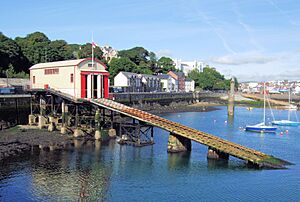
The RNLI has 238 lifeboat stations. Each station has the right kind of lifeboats for its local area. Some larger boats are kept in the water, or launched down a slipway. Smaller boats are often put into the water using trolleys pulled by tractors.
Tower Lifeboat Station on the River Thames in London is the busiest RNLI station. In 2013, its crews rescued 372 people and saved 25 lives.
Many RNLI stations have closed over the years as needs changed. Some of these places now have independent lifeboat services.
Lifeboats and Other Rescue Boats
The RNLI had 432 lifeboats and other rescue boats in 2023. The number changes as old boats are retired and new ones are added. Lifeboats are called 'RNLB' (Royal National Lifeboat). Each boat has an Operation Number, and all-weather lifeboats also have an Official Number (ON).
There are two main types of lifeboats:
- All-weather lifeboats (ALBs) are large boats with enclosed cabins. They can go out in all weather conditions and can right themselves if they capsize. Some ALBs carry a small inflatable boat for working closer to shore. There are five classes of ALBs: Mersey, Trent, Severn, Tamar, and Shannon-class. They can travel at speeds from 17 to 25 knots.
- Inshore lifeboats (ILBs) are inflatable boats or rigid-hulled inflatable boats (RIBs). They work closer to the shore and in shallower water. The smaller ones are called D-class, and the larger ones are called B-class. Special E-class boats work on the River Thames. All ILBs are built and maintained at the RNLI's center in Cowes, Isle of Wight.
Other rescue craft include H-class hovercraft, small inflatable boats, and personal water craft.
People and Equipment
Most lifeboat crews (97%) are volunteers. In 2022, there were over 5,700 lifeboat crew volunteers and more than 4,000 volunteer shore crew. The lifeguard service mainly has paid staff, but there were 98 volunteer lifeguards in 2023.
In the past, women often helped launch and recover lifeboats. It was considered bad luck for women to be part of the crew. Today, more women are joining lifeboat and shore crews.
The first female inshore crew member was Elizabeth Hostvedt in 1969. Frances Glody was the first woman on an all-weather lifeboat crew in 1981. Aileen Pritchard was the first female crew member to receive a medal for bravery. In 2017, Di Bush became the RNLI's first female full-time mechanic, and later the first female full-time coxswain. In 2022, the Cullercoats RNLI station launched its first all-female lifeboat crew.
Lifeboat crews train at their stations and at the Lifeboat College in Poole. They wear special safety clothing. Early lifejackets were made of cork. Later, lighter ones were made of kapok. Today, inflatable 'Crewsaver' lifejackets are used, with different designs for inshore or all-weather crews.
Water Safety Advice

Volunteers (about 1,000 in 2023) give water safety advice and training. They talk to schools, boat users, anglers, divers, and kayakers. The RNLI also runs safety sessions for young people. They share their safety knowledge with other rescue groups around the world.
International Help
The RNLI has helped other countries during disasters. For example, they sent boats and crews to Bangladesh during floods in 1970 and 1988. They also helped in Mozambique in 2000 and Guyana in 2005.
Older RNLI lifeboats are often sold to other countries like Iceland, Uruguay, Chile, and China. The RNLI also helps train people and provides education support in many countries, including Bangladesh and Tanzania.
Money and Support
The RNLI is a charity that saves lives at sea. In 2022, they received £231.1 million.
| Income | £ | % |
|---|---|---|
| Gifts in wills | £140.8 million | 64% |
| Donations | £66.5 million | 30% |
| Lifeguard service charges | £9.8 million | 4% |
| Investments | £3.0 million | 1% |
| Other sources (including government grants) | £1.5 million | 1% |
In 2023, they spent £191.2 million on their charitable work. They also spent £43.9 million (19% of their income) on fundraising.
| Charitable spending | £ | % |
|---|---|---|
| Lifeboat services | £51.0 million | 26% |
| Lifeboat buildings and equipment | £108.2 million | 57% |
| Lifeguard services | £22.5 million | 12% |
| Water safety and education | £6.4 million | 4% |
| International work | £3.1 million | 2% |
A lot of their money comes from gifts left in wills and from special funds. One big supporter is 'The Lifeboat Fund', which has provided 53 lifeboats.
Volunteers run shops and collect money in towns and at open days. Collection boxes are also placed in lifeboat stations.
History and Museums
The RNLI has a special trust that looks after its old objects and records. They run several museums:
- RNLI Historic Lifeboat Collection, Chatham Historic Dockyard
- Grace Darling Museum, Bamburgh
- Henry Blogg Museum, Cromer
- Eastbourne Lifeboat Museum, Eastbourne
- Moelfre Sea Watch Centre, Moelfre, Anglesey
- Poole Old Lifeboat Museum, Poole
- Salcombe Lifeboat Museum, Salcombe
- Whitby Lifeboat Museum, Whitby
Other museums also have RNLI items, like the Zetland Lifeboat Museum in Redcar, which has the world's oldest intact lifeboat.
To celebrate the RNLI's 200th anniversary, there are special exhibitions. One is at the House of Manannan in Peel, Isle of Man, until January 2025. Another, called 'Women of the RNLI', is at The National Maritime Museum in Greenwich until December 2024.
Many old lifeboats have been saved by people who love them. They often appear at events, like historic lifeboat gatherings at Fowey.
RNLI in Media
Newspapers often report on lifeboats, their rescues, and any losses. They have also helped raise money since the 1890s.
The first time an RNLI lifeboat was on TV was in 1947. Since then, many shows have been made about lifeboats and their crews. Viewers of Blue Peter have even raised money to buy many lifeboats.
The BBC drama series Ennal's Point in 1982 was about The Mumbles Lifeboat Station. It showed lifeboat crews as "ordinary men who became extraordinary because of their task, saving life in any weather."
Documentary series have been made about lifeboat stations like Humber and Salcombe. The popular BBC series, Saving Lives at Sea, started in 2016.
On August 2, 2024, a song called "Brave Volunteers" was released by Seth Lakeman and Fisherman's Friends to celebrate the RNLI's 200th anniversary.
The Lifeboat Journal
The RNLI started publishing a journal called The Life-Boat in 1852. It shared information about lifeboats, shipwrecks, rescues, and awards. The name of the journal changed over the years, but it is now called Lifeboat.
RNLI Flag
The first RNLI flag was designed in 1884. It has a Saint George's Cross with red letters for the charity's name. The flag also includes a crown and an anchor. This design was officially adopted in 1908 and is flown at every lifeboat station.
The flag's design has changed twice to show which king or queen is the patron. In 1953, the crown changed for Queen Elizabeth II. After Charles III became King, the flag changed again to use the Tudor crown.
In 1964, the RNLI also got approval for a red ensign flag, which is flown from lifeboats.
Similar Organizations
- Isle of Man Coastguard
- Independent lifeboats in Britain and Ireland
- Other countries have similar groups:
- Royal Netherlands Sea Rescue Institution (Netherlands)
- Société Nationale de Sauvetage en Mer (France)
- German Sea Rescue Society (Germany)
- Norwegian Society for Sea Rescue (Norway)
- Swedish Sea Rescue Society (Sweden)
- Royal Canadian Marine Search and Rescue (Canada)
- National Sea Rescue Institute (South Africa)
See also
 In Spanish: Royal National Lifeboat Institution para niños
In Spanish: Royal National Lifeboat Institution para niños


